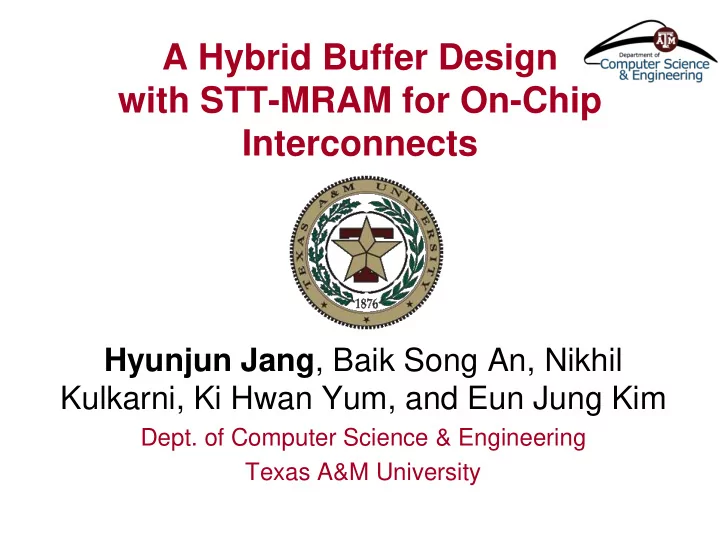

A Hybrid Buffer Design with STT-MRAM for On-Chip Interconnects Hyunjun Jang , Baik Song An, Nikhil Kulkarni, Ki Hwan Yum, and Eun Jung Kim Dept. of Computer Science & Engineering Texas A&M University
Outline Background of NoC Motivation of selecting STT-MRAM Challenges in using STT-MRAM Approaches Hybrid Buffer Design Simple & Lazy Migration Scheme Performance and Power Evaluation Conclusions Hyunjun Jang - NOCS 2012 2
Networks-on-Chip (NoCs) NoCs for Large-Scale Chip Multi-Processors (CMPs) Packet-Switching Networks Switch-based interconnects Scalable More suitable for large-scale Multi-Processor Systems But, Power & Area Budgets in On-Chip Networks are very Limited Hyunjun Jang - NOCS 2012 3
Why STT-MRAM in NoCs Near-zero leakage power compared to SRAM or DRAM Much higher density than SRAM (more than 4xs) Much higher endurance compared to other Non- volatile memories e.g., PCM, or Flash Tolerate much more frequent write accesses STT-MRAM bit storage (MTJ) Hyunjun Jang - NOCS 2012 4
Weaknesses of STT-MRAM Long write latency compared to SRAM More than 10 cycles High write power compared to SRAM More than 8xs To exploit the benefits of STT-MRAM, these challenges should be addressed first Hyunjun Jang - NOCS 2012 5
Approaches Hiding the Long Write Latency, while Maximizing Area Efficiency SRAM + STT-MRAM Hybrid Buffer Design Sacrificing the Retention Time From 10yrs to 10ms Accordingly, latency also changes: 3.2 ns 1.8ns, which is corresponding to 6 cycles in 3GHz clock frequency Reducing the Dynamic Write Power Adaptive flit migration scheme in hybrid buffer considering current SRAM buffer occupancy Hyunjun Jang - NOCS 2012 6
Hybrid Buffer Design Hiding the Long Write Latency (write lat = 6cycles) Hyunjun Jang - NOCS 2012 7
Hybrid Buffer Design Hiding the Long Write Latency (write lat = 6cycles) Hyunjun Jang - NOCS 2012 8
Hybrid Buffer Design Hiding the Long Write Latency (write lat = 6cycles) Hyunjun Jang - NOCS 2012 9
Hybrid Buffer Design Hiding the Long Write Latency (write lat = 6cycles) This is a Simple Migration Scheme Read/Write can be done every cycle But, in a low network load, migration energy is unnecessarily wasted Hyunjun Jang - NOCS 2012 10
Reducing Dynamic Power Consumption Lazy Migration Scheme IF ( SRAM Buffer Occupancy >= Threshold ) Start migrating flits to STT-MRAM ELSE # of flits/ buffer size Maintain flits in SRAM e.g. threshold in SRAM4 case : 0%, 25%, 50%, 75% ref. Credit-based Flow Control Only considers SRAM buffer in credit management Hyunjun Jang - NOCS 2012 11
Front-end SRAM Buffer Size In our experiment, Flits written into buffer stay at least 3 cycles in each on-chip router (Intra-router latency) It is possible to reduce front-end SRAM from 6 to 3 Thus, we can replace more SRAM with STT-MRAM 3cycles Hyunjun Jang - NOCS 2012 12
Various Hybrid Buffer Configurations STT-MRAM is 4xs denser than SRAM Therefore, under the same area budget, 1 SRAM space can be replaced with 4 STT-MRAM space So, under the baseline SRAM6 space, SRAM5-STT4 All these 4 different hybrid SRAM4-STT8 configurations have same area SRAM3-STT12 budget (SRAM6) SRAM2-STT16 Performed experiments to find best hybrid buffer configuration Hyunjun Jang - NOCS 2012 13
Performance/Power Evaluation Performance Model : Cycle-accurate on-chip network simulator Models all router pipeline stages in detail Power Model : Orion for both dynamic and leakage power estimation 8 × 8 Mesh , 2D-Torus, Flattened BFly Topology Routing XY , O1TURN # of VC/Port 4 Buffer Depth/VC SRAM6(baseline) , SRAM5-STT4, SRAM4-STT8, (Same area budget) SRAM3-STT12, SRAM2-STT16 Packet Length 4 flits (128bits/flit) Synthetic Traffic, Benchmark UR , BC, NN, Splash-2 SRAM Read, Write Energy 5.25 (pJ/flit), 5.25 (pJ/flit) SRAM Read, Write Latency 1cycle for Read and Write STT Read, Write Energy 3.826 (pJ/flit), 40.0 (pJ/flit) STT Read, Write Latency 1 cycle for Read , 6 cycles for Write Hyunjun Jang - NOCS 2012 14
Performance Analysis - Different Traffic Traffic (UR) Traffic (BC) 18% 28% Hyunjun Jang - NOCS 2012 15
Performance Analysis - Different Routing, Topology Routing (O1TURN) Topology (2D-Torus) 15% 13% Hyunjun Jang - NOCS 2012 16
Performance Analysis - Various STT Write latencies Write latencies (30, 10, 6 cycles) 18% 13% 11% Hyunjun Jang - NOCS 2012 17
Performance Analysis - Benchmark Test SPLASH-2 parallel benchmarks 34.5% 3.2% Hyunjun Jang - NOCS 2012 18
Power Analysis Dynamic Power Dynamic + Leakage consumption of Input Power consumption of Buffers on-chip routers 1.7xs +4% -16% -53% Hyunjun Jang - NOCS 2012 19
Conclusions Hybrid Buffer Design with STT-MRAM Provide more buffer space under the same area budget Throughput-efficient Performance Improvement 21% on average in synthetic workloads 14% on average in SPLASH-2 parallel benchmarks Power Savings Lazy migration scheme reduces power by 61% on average compared to simple migration scheme Hyunjun Jang - NOCS 2012 20
Recommend
More recommend